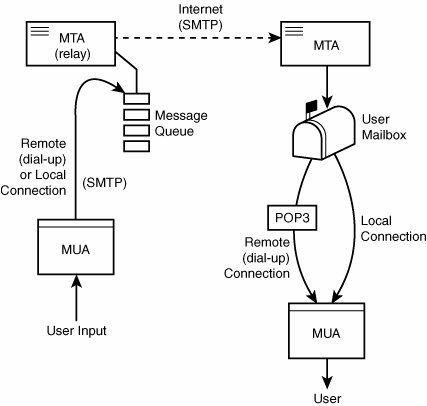Mail Transfer Agents (MTAs) and Mail User Agents (MUAs)
| The role of a Mail Transfer Agent (MTA) is to transfer mail from one mail server to another. The schematic diagram for an email message's path from one person to another is shown in Figure 25.1. Whether the user is on a dial-up connection from a remote site or sitting at the console on the mail server itself, the path the message takes is the same: From the user's input into the Mail User Agent (commonly known as an email client program or similar name), the message moves into the sending SMTP server's message queue, where the MTA (for example, Sendmail) pulls it out as soon as a connection to the receiving SMTP server becomes available and transmits it. (Because this process transmits a message that doesn't originate or terminate on the SMTP server machine itself, this step is known as relaying.) On the remote system, the MTA places the received message into the recipient's mailbox, where it can be read online with a server-side Mail User Agent (MUA) or downloaded to a client-side MUA through POP3 or IMAP. Figure 25.1. Diagram of an email message's path from one user to another, showing the roles of MUAs and MTAs. As a FreeBSD administrator, you'll be interested in the way Sendmail operates as an MTA, both in sender (relay) and receiver roles. This section also discusses MUA programsboth the local kind that users run on the FreeBSD machine itself and the remote kind that operate by uploading and downloading messages. You learn how these programs interact with the "holding areas" of the MTAs: the message queues and the user mailboxes. Common MTAsHere are a few of the Mail Transfer Agent programs routinely used on the Internet:
A great many more MTAs are in general use throughout the Internet; the ones ported to FreeBSD can be found in /usr/ports/mail. Common MUAsMail User Agents are even more numerous than MTAs. Because Windows and Macintosh email clients (such as Microsoft Outlook/Outlook Express, Eudora, Apple Mail, Mozilla Thunderbird, and so on) are so widely understood, the following list contains only the more popular MUAs available for FreeBSD:
Note that the email agents listed here are all shell oriented, meaning that they run in a Telnet or SSH session, monopolizing that session's window. This means they're (almost) exclusively text-based, and such things as inline images and HTML formatting won't work (although they can be configured to open attachments in helper applications, if you're running them on a graphical FreeBSD workstation). However, it also means that you can check your mail using these programs no matter where you're computing fromjust open up a Telnet or SSH session from wherever you are. You'll also be virtually guaranteed to be safe from the Windows/Outlook-oriented viruses that plague the Internet. A number of full-featured, graphical email applications are available for FreeBSD, integrated into the KDE or GNOME environments. These applications turn FreeBSD into a user workstation where graphical, media-rich messages can be directly viewed, as long as you're sitting at the computer's console (it doesn't work so well if the FreeBSD machine is a remote server where the X11 environment is not available to you). For more information on these kinds of email programs, see the "Email Applications" subsection of Chapter 6, "Working with Applications." |
